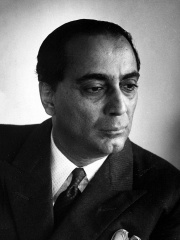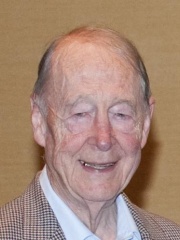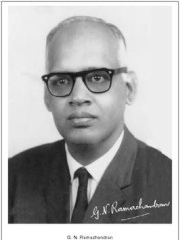







The Most Famous
PHYSICISTS from India
This page contains a list of the greatest Indian Physicists. The pantheon dataset contains 851 Physicists, 16 of which were born in India. This makes India the birth place of the 12th most number of Physicists behind Poland, and Sweden.
Top 10
The following people are considered by Pantheon to be the top 10 most legendary Indian Physicists of all time. This list of famous Indian Physicists is sorted by HPI (Historical Popularity Index), a metric that aggregates information on a biography's online popularity. Visit the rankings page to view the entire list of Indian Physicists.

1. C. V. Raman (1888 - 1970)
With an HPI of 74.29, C. V. Raman is the most famous Indian Physicist. His biography has been translated into 107 different languages on wikipedia.
Sir Chandrasekhara Venkata "C. V." Raman ( RAH-muhn; Tamil: சந்திரசேகர வெங்கட ராமன், romanised: Cantiracēkara Veṅkaṭa Rāmaṉ; 7 November 1888 – 21 November 1970) was an Indian physicist known for his work in the field of light scattering. Using a spectrograph that he developed, he and his student K. S. Krishnan discovered that when light traverses a transparent material, the deflected light changes its wavelength. This phenomenon, a hitherto unknown type of scattering of light, which they called modified scattering was subsequently termed the Raman effect or Raman scattering. In 1930, Raman received the Nobel Prize in Physics for this discovery and was the first Asian and non-White person to receive a Nobel Prize in Physics. Born to Tamil Brahmin parents, Raman was a precocious child, completing his secondary and higher secondary education from St Aloysius' Anglo-Indian High School at the age of 11 and 13, respectively. He topped the bachelor's degree examination of the University of Madras with honours in physics from Presidency College at age 16. His first research paper, on diffraction of light, was published in 1906 while he was still a graduate student. The next year he obtained a master's degree. He joined the Indian Finance Service in Calcutta as Assistant Accountant General at age 19. There he became acquainted with the Indian Association for the Cultivation of Science (IACS), the first research institute in India, which allowed him to carry out independent research and where he made his major contributions in acoustics and optics. In 1917, he was appointed the first Palit Professor of Physics by Ashutosh Mukherjee at the Rajabazar Science College under the University of Calcutta. On his first trip to Europe, seeing the Mediterranean Sea motivated him to identify the prevailing explanation for the blue colour of the sea at the time, namely the reflected Rayleigh-scattered light from the sky, as being incorrect. He founded the Indian Journal of Physics in 1926. He moved to Bengaluru in 1933 to become the first Indian director of the Indian Institute of Science. He founded the Indian Academy of Sciences the same year. He established the Raman Research Institute in 1948 where he worked to his last days. The Raman effect was discovered on 28 February 1928. The day is celebrated annually by the Government of India as the National Science Day.

2. Satyendra Nath Bose (1894 - 1974)
With an HPI of 69.80, Satyendra Nath Bose is the 2nd most famous Indian Physicist. His biography has been translated into 79 different languages.
Satyendra Nath Bose (; 1 January 1894 – 4 February 1974) was an Indian theoretical physicist and mathematician. He is best known for his work on quantum mechanics in the early 1920s, in developing the foundation for Bose–Einstein statistics, and the theory of the Bose–Einstein condensate. A Fellow of the Royal Society, he was awarded India's second highest civilian award, the Padma Vibhushan, in 1954 by the Government of India. The eponymous particles class described by Bose's statistics, bosons, were named by Paul Dirac. A polymath, he had a wide range of interests in varied fields, including physics, mathematics, chemistry, biology, mineralogy, philosophy, arts, literature, and music. He served on many research and development committees in India after independence.

3. Abdul Qadeer Khan (1936 - 2021)
With an HPI of 67.90, Abdul Qadeer Khan is the 3rd most famous Indian Physicist. His biography has been translated into 41 different languages.
Abdul Qadeer Khan (1 April 1936 – 10 October 2021) was a Pakistani nuclear physicist and metallurgical engineer. He is colloquially known as the "father of Pakistan's atomic weapons program". A Muhajir emigrant from India who migrated to Pakistan in 1952, Khan was educated in the metallurgical engineering departments of Western European technical universities where he pioneered studies in phase transitions of metallic alloys, uranium metallurgy, and isotope separation based on gas centrifuges. After learning of India's "Smiling Buddha" nuclear test in 1974, Khan joined his nation's clandestine efforts to develop atomic weapons when he founded the Khan Research Laboratories (KRL) in 1976 and was both its chief scientist and director for many years. In January 2004, Khan was subjected to a debriefing by the Musharraf administration over evidence of nuclear proliferation network selling to Iran, North Korea, Libya, and others, handed to them by the Bush administration of the United States. Khan admitted his role in running this network – only to retract his statements in later years when he levelled accusations at the former administration of Pakistan's Prime Minister Benazir Bhutto in 1990, and also directed allegations at President Musharraf over the controversy in 2008. Khan was accused of selling nuclear secrets illegally and was put under house arrest in 2004. After years of house arrest, Khan successfully filed a lawsuit against the Government of Pakistan at the Islamabad High Court whose verdict declared his debriefing unconstitutional and freed him from house arrest on 6 February 2009. The United States reacted negatively to the verdict and the Obama administration issued an official statement warning that Khan still remained a "serious proliferation risk". On account of the knowledge of nuclear espionage by Khan and his contribution to nuclear proliferation throughout the world post-1970s, and the renewed fear of weapons of mass destruction in the hands of terrorists after the September 11 attacks, former CIA Director George Tenet described Khan as "at least as dangerous as Osama bin Laden". After his death on 10 October 2021, he was given a state funeral at Faisal Mosque before being buried at the H-8 graveyard in Islamabad.

4. Anna Mani (1918 - 2001)
With an HPI of 67.54, Anna Mani is the 4th most famous Indian Physicist. Her biography has been translated into 29 different languages.
Anna Mani (23 August 1918 – 16 August 2001) was an Indian physicist and meteorologist. She retired as the deputy director general of the Indian Meteorological Department and also served as a visiting professor at the Raman Research Institute. Mani made contributions to the field of meteorological instrumentation, conducted research, and published numerous papers on solar radiation, ozone, and wind energy measurements.

5. Tom Kibble (1932 - 2016)
With an HPI of 63.51, Tom Kibble is the 5th most famous Indian Physicist. His biography has been translated into 22 different languages.
Sir Thomas Walter Bannerman Kibble (; 23 December 1932 – 2 June 2016) was a British theoretical physicist, senior research investigator at the Blackett Laboratory and Emeritus Professor of Theoretical Physics at Imperial College London. His research interests were in quantum field theory, especially the interface between high-energy particle physics and cosmology. He is best known as one of the first to describe the Higgs mechanism, and for his research on topological defects. From the 1950s he was concerned about the nuclear arms race and from 1970 took leading roles in promoting the social responsibility of the scientist.

6. Homi J. Bhabha (1909 - 1966)
With an HPI of 62.36, Homi J. Bhabha is the 6th most famous Indian Physicist. His biography has been translated into 43 different languages.
Homi Jehangir Bhabha, FNI, FASc, FRS (30 October 1909 – 24 January 1966) was an Indian nuclear physicist who is widely credited as the "father of the Indian nuclear programme". He was the founding director and professor of physics at the Tata Institute of Fundamental Research (TIFR), as well as the founding director of the Atomic Energy Establishment, Trombay (AEET) which was renamed the Bhabha Atomic Research Centre in his honour. TIFR and AEET served as the cornerstone to the Indian nuclear energy and weapons programme. He was the first chairman of the Indian Atomic Energy Commission (AEC) and secretary of the Department of Atomic Energy (DAE). By supporting space science projects which initially derived their funding from the AEC, he played an important role in the birth of the Indian space programme. Bhabha was awarded the Adams Prize (1942) and Padma Bhushan (1954), and nominated for the Nobel Prize for Physics in 1951 and 1953–1956. He died in the crash of Air India Flight 101 in 1966, at the age of 56.

7. Jayant Narlikar (1938 - 2025)
With an HPI of 60.59, Jayant Narlikar is the 7th most famous Indian Physicist. His biography has been translated into 34 different languages.
Jayant Vishnu Narlikar (19 July 1938 – 20 May 2025) was an Indian astrophysicist who performed research on alternative cosmology. He was also an author who wrote textbooks on cosmology, popular science books, and science fiction novels and short stories. Narlikar studied at Banaras Hindu University and Cambridge University, where he obtained his PhD in 1963 working with Fred Hoyle. After postdoctoral work in Cambridge, in 1972 he was appointed a professor at the Tata Institute of Fundamental Research. In 1988, he became the first director of the Inter-University Centre for Astronomy and Astrophysics (IUCAA).

8. Vikram Sarabhai (1919 - 1971)
With an HPI of 59.28, Vikram Sarabhai is the 8th most famous Indian Physicist. His biography has been translated into 33 different languages.
Vikram Ambalal Sarabhai (12 August 1919 – 30 December 1971) was an Indian physicist and astronomer who initiated space research and helped to develop nuclear power in India. Often regarded as the "Father of Indian space program", Sarabhai was honored with Padma Bhushan in 1966 and the Padma Vibhushan (posthumously) in 1972.

9. Prasanta Chandra Mahalanobis (1893 - 1972)
With an HPI of 57.73, Prasanta Chandra Mahalanobis is the 9th most famous Indian Physicist. His biography has been translated into 27 different languages.
Prasanta Chandra Mahalanobis OBE, FNA, FASc, FRS (29 June 1893 – 28 June 1972) was an Indian scientist and statistician. He is best remembered for the Mahalanobis distance, a statistical measure, and for being one of the members of the first Planning Commission of free India. He made pioneering studies in anthropometry in India. He founded the Indian Statistical Institute, and contributed to the design of large-scale sample surveys. For his contributions, Mahalanobis has been considered the father of statistics in India. Since 2007, June 29 is celebrated as National Statistics Day in India to commemorate the birth anniversary of P.C. Mahalanobis and his contributions to statistical science and planning.

10. Udupi Ramachandra Rao (1932 - 2017)
With an HPI of 57.15, Udupi Ramachandra Rao is the 10th most famous Indian Physicist. His biography has been translated into 17 different languages.
Udupi Ramachandra Rao (10 March 1932 – 24 July 2017) was an Indian space scientist and former chairman of ISRO. He was also the Chairman of the Governing Council of the Physical Research Laboratory at Ahmedabad and Nehru Planetarium at Bengaluru and chancellor of the Indian Institute for Space Science and Technology (IIST) at Thiruvananthapuram. He is known as "The Satellite Man of India". He pioneered India's first satellite launch Aryabhata in 1975. Rao was awarded the Padma Bhushan by the Government of India in 1976, and the Padma Vibhushan in 2017. He was inducted into the Satellite Hall of Fame, Washington, on 19 March 2013 at a ceremony organised by the Society of Satellite Professionals International. With this he became the first Indian to be inducted. He was also to be inducted in International Astronautics Federation (IAF) on 15 May 2016. He was again the first Indian to achieve such a feat.
People
Pantheon has 16 people classified as Indian physicists born between 1888 and 1956. Of these 16, 2 (12.50%) of them are still alive today. The most famous living Indian physicists include Abhay Ashtekar, and Ashoke Sen. The most famous deceased Indian physicists include C. V. Raman, Satyendra Nath Bose, and Abdul Qadeer Khan.
Living Indian Physicists
Go to all RankingsDeceased Indian Physicists
Go to all RankingsC. V. Raman
1888 - 1970
HPI: 74.29
Satyendra Nath Bose
1894 - 1974
HPI: 69.80
Abdul Qadeer Khan
1936 - 2021
HPI: 67.90
Anna Mani
1918 - 2001
HPI: 67.54
Tom Kibble
1932 - 2016
HPI: 63.51
Homi J. Bhabha
1909 - 1966
HPI: 62.36
Jayant Narlikar
1938 - 2025
HPI: 60.59
Vikram Sarabhai
1919 - 1971
HPI: 59.28
Prasanta Chandra Mahalanobis
1893 - 1972
HPI: 57.73
Udupi Ramachandra Rao
1932 - 2017
HPI: 57.15
Daulat Singh Kothari
1906 - 1993
HPI: 50.90
G. N. Ramachandran
1922 - 2001
HPI: 50.28
Overlapping Lives
Which Physicists were alive at the same time? This visualization shows the lifespans of the 14 most globally memorable Physicists since 1700.





